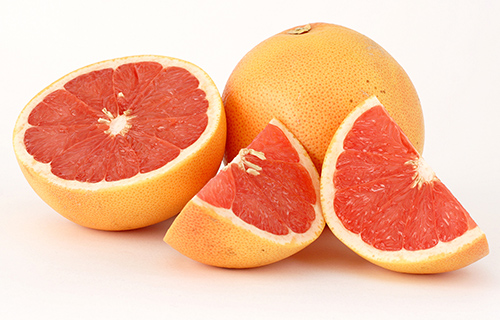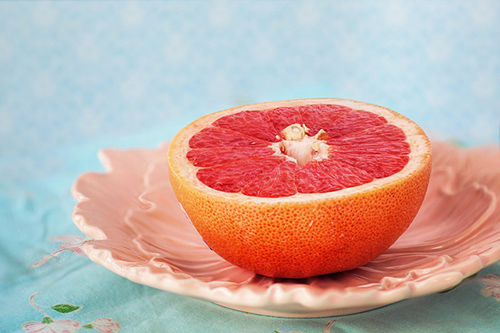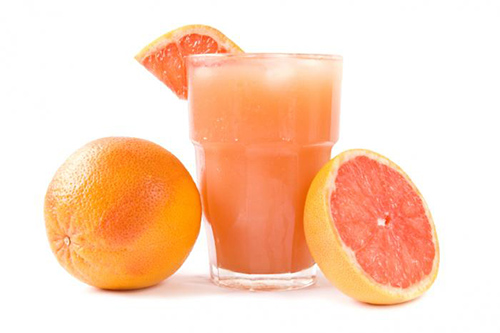If the benefits of grapefruit convince you to try it for the first time, the experience may be somewhat unpleasant: not as sweet as an orange, not as acid as a lemon, and mildly sour. Firstly, this original mixture of flavors may seem odd; however, everyone eventually gets accustomed to it.
Grapefruits are the largest of all citrus fruits. It is also one of the most researched fruits today. Because of its structure and medicinal properties, this fruit continues to perplex scientists who attempt to find the secrets to the many health benefits of grapefruit.
How to Use

- Fresh: It is beneficial to eat the whole grapefruit, including the white layer below the peel and between the segments, thanks to its fiber-rich pectin.
- Benefits of grapefruit juice: The juice is an excellent alternative to the orange or lemon, combined with either. You can sweeten your drink with honey if you like.
- Grapefruit treatment: You can do this with the whole fruit or the juice. The treatment starts with eating a grapefruit on an empty stomach (the entire fruit or juice), two doses the next day, and up to five. When you reach five a day, lower the amount by one each day until you get to one. Continue eating one grapefruit daily for five days until you complete the two-week treatment course.
There are grapefruit varieties with yellow, orange, and even pink pulp. The latter two have the advantage of being incredibly rich in carotenoids for preventative action against cancer.
The juice of this fruit is rich in antioxidants such as vitamin C, carotenoids, and flavonoids; however, it contains much less pectin (soluble fiber) than the entire fruit. People suffering from arteriosclerosis should eat the whole fruit with its pulp for the best results.
Scientific Facts
- Scientific synonyms: Citrus maxima (Burm.) Merr., Citrus decumanus L.
- Synonyms: Marsh grapefruit, Shaddock;
- French: Pamplemousse, pomelo;
- Spanish: Pomelo
- German: Grapefruit
- Description: The grapefruit is the fruit of the tree’ Citrus paradisi’ MacFad., from the botanical family Rutaceae. It is shaped like an orange, although somewhat more massive, and is lemon-like. Some varieties are pink or green.
- Habitat: Originally from Southeast Asia, its cultivation has spread to Israel, Mediterranean countries, Caribbean islands, and the North American states of Florida, California, Arizona, and Texas.
Benefits of Grapefruit
The grapefruit pulp comprises a modest amount of carbohydrates and very few lipids and proteins. C is this fruit’s most prominent vitamin, although less than that of the orange or the lemon. Its virtual lack of sodium is notable for mineral salts, as is its addition to a certain sum of magnesium and calcium.

Since its nutritional content is relatively low, most grapefruit benefits result from its non-nutritive components. These additional substances, which you can find in all plant-based foods and do not form part of any specific groups of nutrients, are precisely those that stimulate the most curiosity within the scientific community.
Though grapefruit contains hundreds of non-nutritive components like the orange, the function of only a few is understood. These components include carotenoids, limonoids, flavonoids, and pectin.
Pectin: This is a soluble vegetable fiber found in various fruits such as apples and citrus. Because of its medicinal properties, vegetable fiber was among the first non-nutritive components studied. You can find grapefruit pectin in the fiber that forms the fruit’s pulp and between the whitish layer’s secretions just below the skin. This fiber contributes to grapefruit’s health benefits by its ability to protect the arteries and its anti-cholesterol effects.

Flavonoids: These consist of a collection of non-nutritive components called phytochemicals. These chemicals are glycosides, and they are prevalent in plant-based foods, which continue to amaze scientists because of their medicinal properties. Naringin is the main glucoside that you can find in grapefruit, and it converts into naringenin within the body. It improves blood flow and possesses anticarcinogen as well as antioxidant properties.
Carotenoids: PINK GRAPEFRUIT is an excellent source of beta-carotene, the forerunner to vitamin A. This particular grapefruit also contains a variety of other substances called carotenoids. These substances act similarly and facilitate the antioxidant effects of vitamin C and flavonoids.
Limonoids: Limonoids are terpenoids that give citrus fruits their essence. Grapefruits are extremely rich in one particular terpenoid, and that is limonene. It is responsible for the fruits’ bitter taste and many of the proven anticarcinogenic properties.
The grapefruit’s non-nutritive and nutrient components explain the many benefits of grapefruit:
Arteriosclerosis
The calcification caused by the buildup of cholesterol, known as arteriosclerosis, is prevented by the grapefruit from hardening and thickening artery walls. The grapefruit promotes circulation by increasing the amount of blood that reaches the tissues. Pectin (soluble fiber) is the non-nutritive substance most closely linked to this outcome.
Suppose the whole fruit is consumed instead of only the pectin that has been extracted. Grapefruit’s preventive and therapeutic benefits on arteriosclerosis are more prominent in that case. This is most likely due to the grapefruit flavonoid naringin’s ability to reduce blood hematocrit levels when high (more than fifty-five percent).
HEMATOCRIT is a metric for blood cell concentration. The blood becomes more fluid and flows more quickly through the arteries when the action of grapefruit returns the hematocrit to normal levels. Blood clots, arteriosclerosis’s most serious side effect, are less likely. It is important to note that grapefruit does not further lower the hematocrit when it is already low due to anemia. Nevertheless, it oddly rises toward more typical levels.
Similarly, vitamin C guards the arteries and helps lower cholesterol levels. Its action enhances and boosts the effectiveness of naringin and pectin. Thus, grapefruit’s constituent parts work together to produce favorable results:
- On the arterial walls, strengthening their interior diameter and
- On the blood, making it more fluid.
Whether or not clotting is a factor, using the whole grapefruit, including the pulp (rather than just the juice), is advantageous for treating all types of arteriosclerosis:
- Cerebral (lack of circulation to the brain);
- Coronary (heart attack, angina pectoris);
- Peripheral (lack of circulation to the limbs, particularly the legs).
Other Cardiocirculatory Conditions
With almost little salt or fat and high potassium content, grapefruit is an excellent food for those with heart disease, especially those with heart failure. Grapefruit has a modest diuretic action that helps to clear the circulatory system. Therefore, those with hypertension should consume enough of it. The juice is sufficient in these circumstances. However, the circulatory system benefits are better accessed by utilizing the entire fruit, including the pulp.
Gout, Uratic Arthritis, Kidney Stones
Although lemons work better in certain situations, grapefruit also produces positive outcomes. If you can’t eat lemons, this is a suitable substitute.
Depurative Treatments
Anytime one wants to “clear the blood,” one may drink a glass of grapefruit juice first thing in the morning. This will help the body’s detoxifying processes (especially those in the liver). The finest results come from sticking to this regimen for a month while taking one or two days off. The grapefruit’s ability to cleanse the body is explained, at least in part, by the limonoids that it contains, which stimulate the liver’s detoxification enzymes (cytochromes and glutathione S-transferase).
Infections
Because of its vitamin C and flavonoid content, grapefruit boosts immune system activities like the orange.
Obesity
Despite being often suggested in such regimens, grapefruit does not aid in weight reduction. However, it is an excellent addition to the diet of anybody looking to reduce weight due to its depurative and cleansing effects. The most efficient way to do this is to use grapefruit juice-based therapy.
Protection Against Cancer
By preventing the action of various carcinogenic chemicals, the vitamin C, pectin, and limonoids found in grapefruits specifically help prevent cancer. Consuming grapefruit and other citrus fruits often is a great cancer prevention strategy.
How to Prepare a Grapefruit
To prepare this fruit to take full advantage of the benefits of grapefruit and its nutritional properties, you will need to hold on to the white layer below the rind. This area is the richest in pectin, a soluble fiber.
- Use any peeler of your choice to remove the thin yellow rind.
- Cut all of the pulp into thin slices.
- You can sweeten it with honey.
Warning About Grapefruit Side Effects
According to health experts, certain phytochemicals of the flavonoid group in grapefruit, particularly naringin, inhibit the activity of enzymes responsible for metabolizing certain medications. These enzymes, found primarily in the liver, belong to a system called cytochrome P450. To date, two known types of drugs interact negatively with grapefruit:
- Calcium channel-blocking agents (nifedipine and similar drugs) used in cases of coronary heart disease and hypertension
- Cyclosporine and immunosuppressant used in organ transplant cases, particularly of the kidney
When one eats grapefruit, these medications metabolize more slowly, remain longer in the bloodstream, and, as a result, have a more intense effect. Those who regularly eat grapefruit and require treatment with these medications should consult with their physician to adjust for optimal dosage.
DISCLAIMER: All content on this website is presented solely for educational and informational objectives. You should not rely on the information provided as a replacement for advice, diagnosis, or treatment from a qualified medical expert. If you are pregnant, nursing, or have any preexisting medical concerns, you should talk to your doctor before using any herbal or natural medicines.
REFERENCES
- George D. Pamplona-Roger, M.D. “Encyclopedia of Foods and Their Healing Power.” George D. Pamplona-Roger, M.D. Encyclopedia of Foods and Their Healing Power. Trans. Annette Melgosa. Vol. 2. Chai Wan: Editorial Safeliz, 2005. 93-96. Print. [benefits of grapefruit]
- Vitamin C comparison: https://www.healthline.com/nutrition/10-benefits-of-grapefruit
- Medication interaction: https://www.fda.gov/consumers/consumer-updates/grapefruit-juice-and-some-drugs-dont-mix
